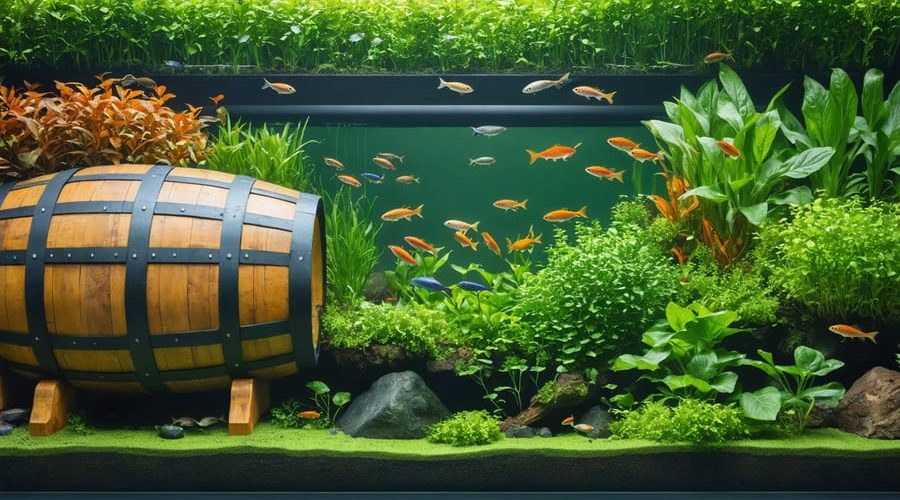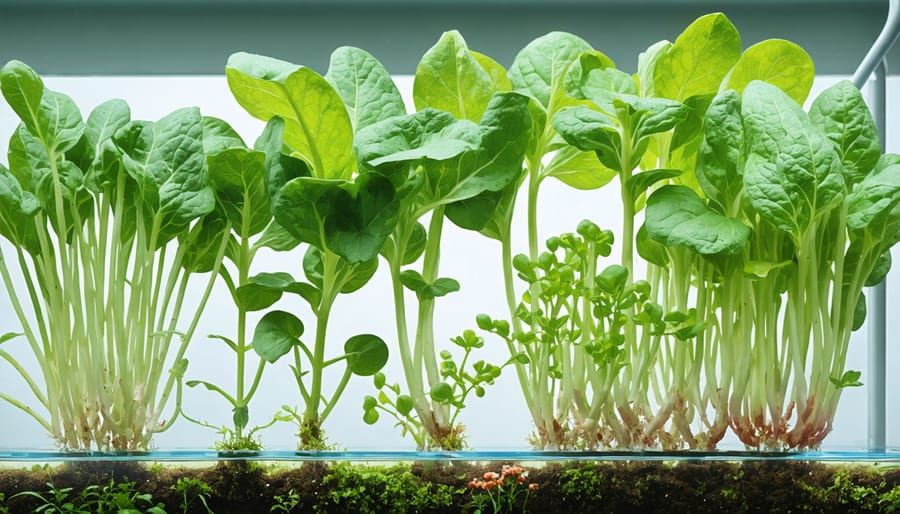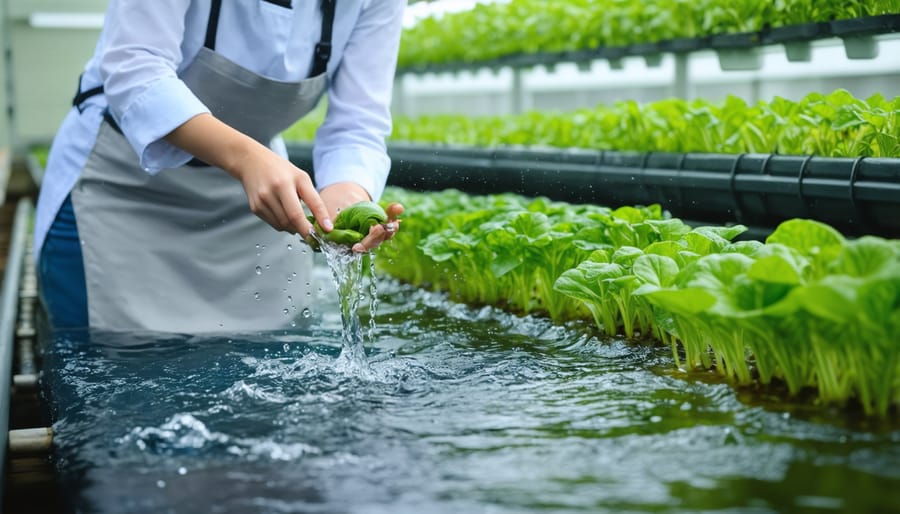
Perfect Your Aquaponics: Make Every Nutrient Count for Healthier Plants and Fish
In aquatic ecosystems, the delicate balance of nutrients determines the health and productivity of the entire system. Just as a chain is only as strong as its weakest link, an aquaponic system thrives or struggles based on its most limited nutrient. Nitrogen and phosphorus typically play starring roles as limiting nutrients, acting like natural speed governors that control ecosystem growth. Understanding these limitations isn’t just academic – it’s the key to maintaining thriving water gardens, ponds, and aquatic habitats.
When one essential nutrient becomes scarce, it creates a bottleneck that restricts the growth of plants and algae, regardless of how abundant other nutrients might be. This principle, known as Liebig’s Law of the Minimum, shapes everything from backyard ponds to vast ocean ecosystems. For home water gardeners and aquaponics enthusiasts, identifying and managing limiting nutrients opens the door to healthier, more productive systems where fish and plants flourish together in perfect harmony.
By understanding how limiting nutrients work, you’ll be better equipped to spot early warning signs of deficiency and take action before problems arise. This knowledge transforms maintaining your aquatic ecosystem from guesswork into a rewarding science.
The Limiting Nutrient Concept Made Simple
Liebig’s Law in Your Pond
Think of your pond like a recipe – you need all the right ingredients in the right amounts for success! This is exactly what Justus von Liebig discovered when he developed his Law of the Minimum. It’s a simple but powerful concept: growth is limited by whichever nutrient is in shortest supply, even if you have plenty of everything else.
Imagine building a wooden barrel with different-length staves. The barrel can only hold water up to the height of the shortest stave – that’s your limiting nutrient! In your pond, this principle directly affects plants and fish health. If phosphorus is low, for example, adding more nitrogen won’t help growth until you address the phosphorus shortage.
This law helps us understand why sometimes our ponds aren’t thriving despite our best efforts. By identifying which nutrient is in shortest supply, we can make targeted improvements instead of randomly adding supplements. It’s like solving a puzzle – once you find the missing piece, everything else falls into place!

Common Limiting Nutrients in Aquaponics
In aquaponic systems, certain nutrients commonly become limiting factors that can affect plant growth and overall system health. Iron is often the first nutrient to become scarce, as fish feed typically doesn’t provide enough of this essential element. Plants may show yellowing leaves when iron runs low. Potassium is another frequent limiting nutrient, especially in systems growing fruiting plants like tomatoes or peppers.
Calcium and magnesium deficiencies are also common, particularly in systems using soft water. These minerals are crucial for plant development and fish health alike. While nitrogen is abundant in most aquaponic systems thanks to fish waste, phosphorus can sometimes be in short supply, leading to stunted plant growth and poor root development.
Many aquaponic gardeners find that zinc and manganese may also become limiting factors, especially in systems with pH levels above 7.0, as these nutrients become less available to plants in alkaline conditions. Regular water testing and observation of plant health can help identify these limiting nutrients before they cause significant problems.
Remember, maintaining proper pH levels and occasionally supplementing with fish-safe nutrients can help prevent most deficiency issues in your system.
Spotting Nutrient Limitations in Your System
Plant Warning Signs
Just like a detective looking for clues, you can spot nutrient limitations in your aquatic plants through several telltale signs. The most common indicator is yellowing leaves, particularly in older growth. If you notice your plants looking pale or losing their vibrant green color, they might be crying out for more nitrogen.
Another warning sign is stunted growth. When plants that usually grow quickly seem to hit a plateau, or new leaves appear smaller than usual, you’re likely dealing with a phosphorus limitation. Watch for reddish or purple tinges on leaves too – this is often a desperate call for phosphorus from your aquatic friends.
Keep an eye on leaf patterns. If you spot dark green veins but pale areas between them, your plants might be running low on iron. Twisted or curled new growth often points to calcium deficiency, while brown spots or decay at leaf tips typically signal a potassium shortage.
Algae overgrowth can actually be a warning sign too. When your desired plants can’t access the nutrients they need, algae often step in to fill the gap, creating an unsightly green mess in your pond or aquarium.
Remember, these signs rarely appear in isolation. Your plants might show multiple symptoms at once, so it’s important to observe the overall health of your aquatic ecosystem regularly.

Fish Health Indicators
Watching for signs of fish health is one of the best ways to spot nutrient problems in your pond or aquatic system. Happy, healthy fish are usually active, have bright colors, and swim with smooth, natural movements. When nutrient levels get out of balance, you might notice some concerning changes in your finned friends.
Keep an eye out for fish that spend a lot of time near the water’s surface gasping for air – this could mean there’s not enough oxygen due to excess nutrients causing algae blooms. Sluggish swimming or fish that appear less active than usual might indicate stress from poor water quality. Look for any changes in fish coloration too; dull or fading colors can be a sign that something’s not quite right with your water chemistry.
Physical symptoms like ragged fins, visible sores, or a slimy coating on the scales are red flags that shouldn’t be ignored. These could mean your fish are struggling with the effects of nutrient imbalances. You might also notice fish rubbing against surfaces or rocks, almost like they’re trying to scratch an itch – this behavior often signals they’re uncomfortable with their water conditions.
If you spot any of these warning signs, it’s time to test your water parameters and check your nutrient levels. Remember, healthy fish are one of the best indicators of a well-balanced aquatic ecosystem!
Balancing Your System’s Nutrients
Testing and Monitoring
Regular monitoring of nutrient levels is crucial for maintaining optimal balance in your aquatic ecosystem. The good news is that you don’t need to be a scientist to keep track of your pond’s nutrient levels! Start with basic water testing kits available at most garden centers. These kits typically measure essential nutrients like nitrogen, phosphorus, and potassium.
For best results, test your water weekly during the growing season and monthly during winter. Keep a simple logbook to track changes over time – this will help you spot patterns and potential issues before they become problems. When testing, take samples from different areas of your pond and at various depths for more accurate readings.
Pay special attention to signs that might indicate nutrient imbalances. Excessive algae growth often suggests too much phosphorus, while yellowing plants might signal nitrogen deficiency. If you notice these signs, increase your testing frequency to better monitor the situation.
Modern digital meters can provide instant readings, but traditional drop-test kits work just fine for most home ponds. Remember to calibrate your testing equipment regularly and store test kits in a cool, dry place to maintain accuracy.
Don’t forget to monitor your pond’s pH levels too, as this affects how plants absorb nutrients. Most aquatic plants thrive in slightly acidic to neutral water (pH 6.5-7.5). Make adjustments gradually – sudden changes can stress your pond’s inhabitants.

Safe Supplementation Strategies
Adding nutrients to your aquatic ecosystem requires a careful, balanced approach to avoid harmful algae blooms or stress on aquatic life. Here’s how to supplement nutrients safely and effectively.
Start by testing your water parameters weekly using reliable test kits. This helps you identify which nutrients are actually lacking before adding supplements. Remember, it’s easier to add nutrients than to remove excess ones!
When supplementing, follow these golden rules:
1. Start with half the recommended dose on product labels
2. Wait 48-72 hours before retesting
3. Add supplements gradually over several days
4. Monitor your fish and plants for any stress signals
For most home ponds and water gardens, liquid fertilizers work best as they disperse evenly. Choose products specifically designed for aquatic environments – never use regular garden fertilizers, which can be toxic to fish.
Here’s a safe supplementation schedule:
– Week 1: Add 25% of the calculated dose
– Week 2: Increase to 50% if plants show positive response
– Week 3: Move to 75% if needed
– Week 4: Reach full dosage if necessary
Consider using natural methods first:
– Adding beneficial bacteria
– Including floating plants that naturally absorb excess nutrients
– Using substrate fertilizer tabs for rooted plants
– Maintaining proper fish stocking levels
Watch for warning signs of over-supplementation:
– Sudden algae growth
– Fish gasping at the surface
– Cloudy water
– Unusual plant growth patterns
If you notice any of these signs, immediately stop supplementing and perform a partial water change. Remember, a balanced ecosystem often needs minimal intervention – sometimes less is more when it comes to nutrient management.
Natural Balance Solutions
Maintaining nutrient balance in your aquatic ecosystem doesn’t always require chemical interventions. Nature provides several effective solutions that can help you create a self-sustaining system while keeping those pesky limiting nutrients in check.
Start by introducing floating plants like water lettuce or duckweed, which are natural nutrient sponges. These plants quickly absorb excess nutrients, particularly nitrogen and phosphorus, helping prevent algae blooms. Plus, they provide lovely shade and shelter for fish!
Consider creating a designated plant filter zone in your pond. This area, filled with emergent plants like cattails and rushes, acts as a natural filtering system. These plants are particularly good at removing nutrients through their root systems, and they add visual interest to your water feature.
Another effective approach is introducing beneficial bacteria through natural substrates. Layer some lava rock or bio-balls in your filtration system – these provide perfect homes for beneficial bacteria that help break down excess nutrients. Think of them as your pond’s tiny cleanup crew!
Don’t forget about bottom-feeding fish like koi or goldfish. They naturally stir up sediment while foraging, preventing nutrient buildup in the substrate. Just be mindful not to overstock – too many fish can tip the balance in the wrong direction.
Regularly removing fallen leaves and debris is a simple but powerful natural method. This organic matter, if left to decompose, releases nutrients back into the water. A quick skim with a net every few days works wonders in maintaining that perfect balance.
Understanding and managing limiting nutrients in your aquatic ecosystem is key to maintaining a thriving, balanced environment. As we’ve explored throughout this article, these essential elements play a crucial role in the health and sustainability of your water feature, whether it’s a backyard pond, water garden, or aquaponics system.
Remember that nitrogen and phosphorus are typically the most common limiting nutrients, but your specific situation might vary. The key is regular monitoring and observation of your system. Keep an eye out for those telltale signs we discussed – unusual algae growth, poor plant development, or changes in water clarity. These are your system’s way of communicating that something might be out of balance.
Don’t feel overwhelmed by the technical aspects of nutrient management. Start with simple water testing kits and maintain a regular testing schedule. Make it part of your weekly or monthly routine, just like checking your garden or feeding your fish. Keep a log of your readings – this will help you spot patterns and make better decisions about nutrient management over time.
Consider taking a proactive approach by implementing some of the preventive measures we’ve covered. Regular maintenance, proper fish feeding schedules, and strategic plant selection can go a long way in maintaining nutrient balance naturally. Remember, it’s often easier to prevent nutrient issues than to correct them once they’ve become problematic.
Most importantly, be patient and observant. Every aquatic ecosystem is unique and may require different approaches to maintain optimal nutrient levels. Don’t be afraid to make adjustments based on what you observe, and remember that small, gradual changes are often more effective than dramatic interventions.
By staying attentive to your system’s needs and applying the principles we’ve discussed, you’ll be well on your way to maintaining a beautiful, healthy aquatic environment that brings joy and satisfaction for years to come. Happy water gardening!
